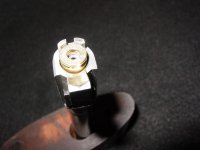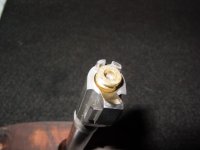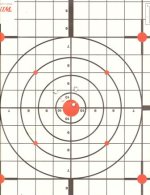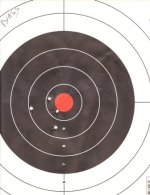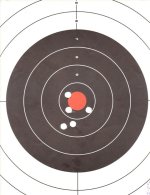The first picture is the newest addition to my Bullseye and ISSF tools, a Smith Wesson Model 952-2 (in 9mm caliber) that is pictured alongside my SW 52-2 in 38 caliber. The 952 is very similar to my 52-2 except with a major design change of the barrel bushing, the addition of a firing pin grip safety, stainless instead of blued steel and capable of firing other bullet configurations besides the full wad cutter. The other differences for the 952 are mostly cosmetic including different rear site, a dovetail front site, non serrated trigger, Allen screws on wood grips, no rail to install a counter weight and no trigger stop. There is an adjustment that allows taking up any slack/creep in the trigger. The trigger pull is a little heavier (3.5 versus 2.5 pounds) but still just as smooth. When the gun is locked there is no rattle anywhere. The issue of follow through that exists with the 52 does not apply to the 952 because the cycling is very fast. The firearm is well balanced and easy to hold on target and because of the weight (40.1 oz) recoil is mild. Field stripping is very similar; however, reassembly is different because of the barrel bushing design. The 52 has a screw in bushing whereas the 952 uses a titanium coated bushing that sits inside a fixed housing. The tolerance is so tight that the only way I found to insert the barrel is to rotate the bushing with your little finger until it matches with the barrel and then the barrel will slide freely inside the bushing.
For the 38 and 45 there was not any literature suggesting case length is important for accuracy. For the 9mm I did find an article by Taylor (www.leverguns.com/articles/taylor/9mm_reloading[/COLOR]) suggesting case length and mixed brass may have an impact on accuracy. Winchester brass and primers were used in all testing. A total of 112 cases were sorted and 44 were 0.750 as suggested by Taylor as being the most accurate (which is the recommended trim length). A total of 55 cases ranged from 0.747 to 0.749 with 11 cases that were outside of these ranges. Mixed brass consisted of Blazer, WCC, AUU, FC, UBC, and PAO.
Two bullets were tested Sierra 115 gr. FMJ Target Master and the second was Penn 115 gr. LSWC at 0.356 diameter. The case/barrel method was used to determine the OAL and two pictures are provided showing the case in the barrel chamber without any bullet and then the case with a bullet seated to a depth matching the without bullet depth. This technique produced for the Sierra 115 gr. FMJ Target Master an OAL of at 1.1255 and for the Penn 115 gr. LSWC an OAL of 1.0960 -- a taper crimp of 0.375 was selected for both rounds. I checked the Penn cast bullets by selecting 15 random bullets and weighing them and finding a mean of 112.4 gr., std. dev. of 0.17 gr., a 90% confidence interval of 0.0055 and a coefficient of variation less than 1 percent. I then checked all 500 and found two that were 113.0 gr. and one that did not have a full coating of lube in the cannelure; which are impressive statistics for this bullet.
All testing was done at 40 yards which is the maximum distance at my range from a fixed rest. A tiered approach for powder selection was used by first starting with those powders listed for each caliber’s bullet; the second tier consisted of selecting those powders that were obtainable locally and the third tier was choosing those powders that have at least a 0.5 gr. difference between min and max load. Based on these tiers Hodgdon HP38, Universal Clays, Titegroup and Winchester Auto Comp were selected.
For Sierra Match 115 gr. FMJ the best group was Universal Clays at 4.5 gr. (that produced a center to center group of 1.3 in.) and for the Penn 115 gr. cast LSWC HP38 at 4.4 gr. (that produced 1.4 inch group). I have triple checked these numbers but review your sources before trying these yourself.
I then loaded the Universal Clays charge into the shortest and longest Winchester brass and added two other randomly selected mixed brass cases and retested. A group size of 1.8 inches was produced or 0.5 inches larger than the smallest of the sorted single head stamp brass. Mixed brass does seem to impact accuracy (at least at 40 yards). I did find one article Handloading Tips for 9mm HANDLOADING TIPS for 9mm - CZF AMMUNITION-FACTORY AND HANDLOADED - GENERAL - CZFORUM.COM - Message Board that does recommend sorting by head stamp and whether any of this is important would depend on the type of shooting.
For the 38 and 45 there was not any literature suggesting case length is important for accuracy. For the 9mm I did find an article by Taylor (www.leverguns.com/articles/taylor/9mm_reloading[/COLOR]) suggesting case length and mixed brass may have an impact on accuracy. Winchester brass and primers were used in all testing. A total of 112 cases were sorted and 44 were 0.750 as suggested by Taylor as being the most accurate (which is the recommended trim length). A total of 55 cases ranged from 0.747 to 0.749 with 11 cases that were outside of these ranges. Mixed brass consisted of Blazer, WCC, AUU, FC, UBC, and PAO.
Two bullets were tested Sierra 115 gr. FMJ Target Master and the second was Penn 115 gr. LSWC at 0.356 diameter. The case/barrel method was used to determine the OAL and two pictures are provided showing the case in the barrel chamber without any bullet and then the case with a bullet seated to a depth matching the without bullet depth. This technique produced for the Sierra 115 gr. FMJ Target Master an OAL of at 1.1255 and for the Penn 115 gr. LSWC an OAL of 1.0960 -- a taper crimp of 0.375 was selected for both rounds. I checked the Penn cast bullets by selecting 15 random bullets and weighing them and finding a mean of 112.4 gr., std. dev. of 0.17 gr., a 90% confidence interval of 0.0055 and a coefficient of variation less than 1 percent. I then checked all 500 and found two that were 113.0 gr. and one that did not have a full coating of lube in the cannelure; which are impressive statistics for this bullet.
All testing was done at 40 yards which is the maximum distance at my range from a fixed rest. A tiered approach for powder selection was used by first starting with those powders listed for each caliber’s bullet; the second tier consisted of selecting those powders that were obtainable locally and the third tier was choosing those powders that have at least a 0.5 gr. difference between min and max load. Based on these tiers Hodgdon HP38, Universal Clays, Titegroup and Winchester Auto Comp were selected.
For Sierra Match 115 gr. FMJ the best group was Universal Clays at 4.5 gr. (that produced a center to center group of 1.3 in.) and for the Penn 115 gr. cast LSWC HP38 at 4.4 gr. (that produced 1.4 inch group). I have triple checked these numbers but review your sources before trying these yourself.
I then loaded the Universal Clays charge into the shortest and longest Winchester brass and added two other randomly selected mixed brass cases and retested. A group size of 1.8 inches was produced or 0.5 inches larger than the smallest of the sorted single head stamp brass. Mixed brass does seem to impact accuracy (at least at 40 yards). I did find one article Handloading Tips for 9mm HANDLOADING TIPS for 9mm - CZF AMMUNITION-FACTORY AND HANDLOADED - GENERAL - CZFORUM.COM - Message Board that does recommend sorting by head stamp and whether any of this is important would depend on the type of shooting.


